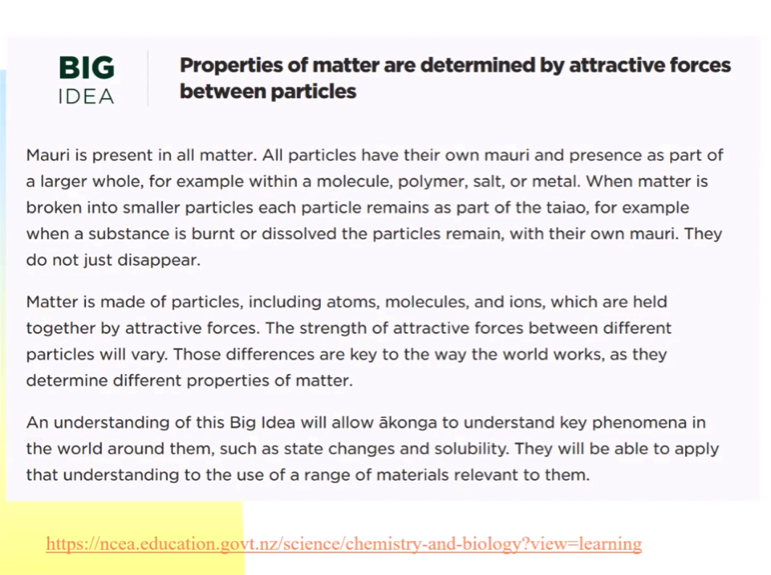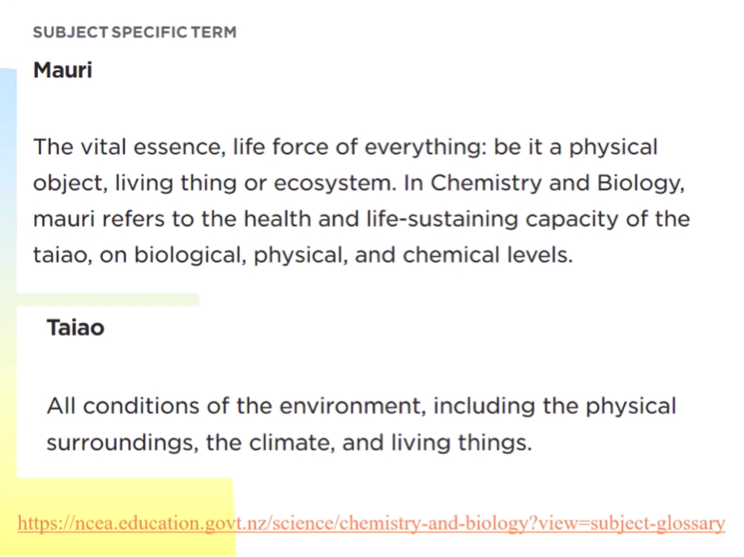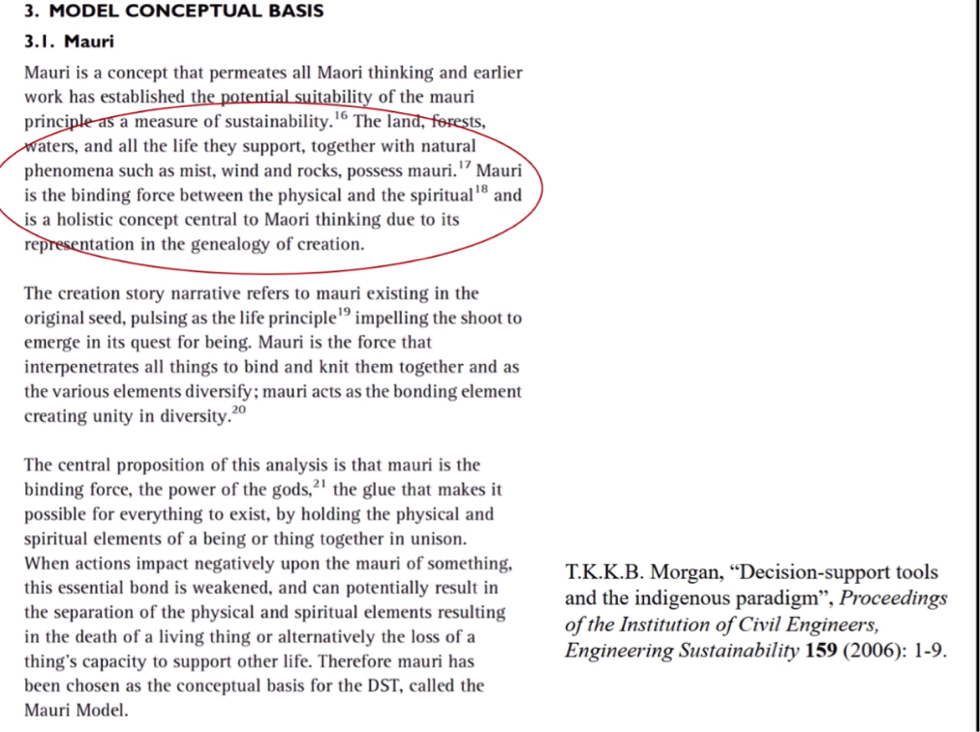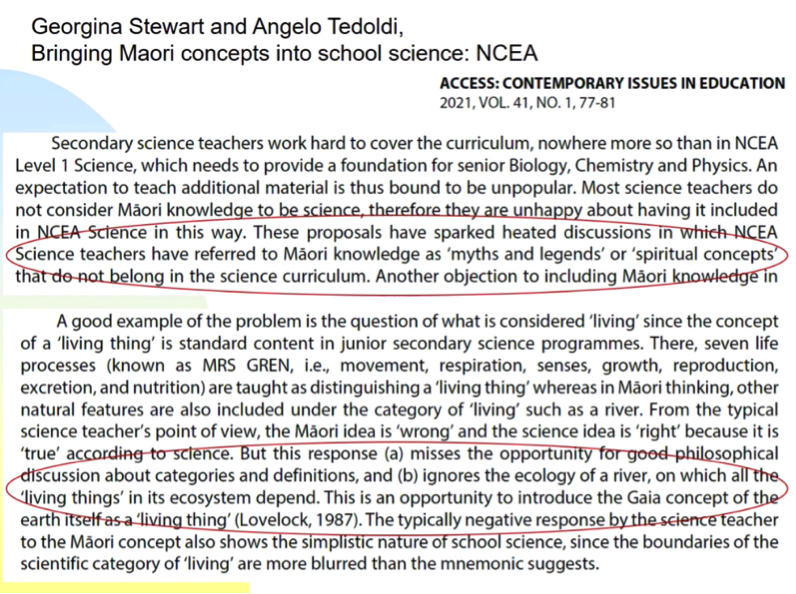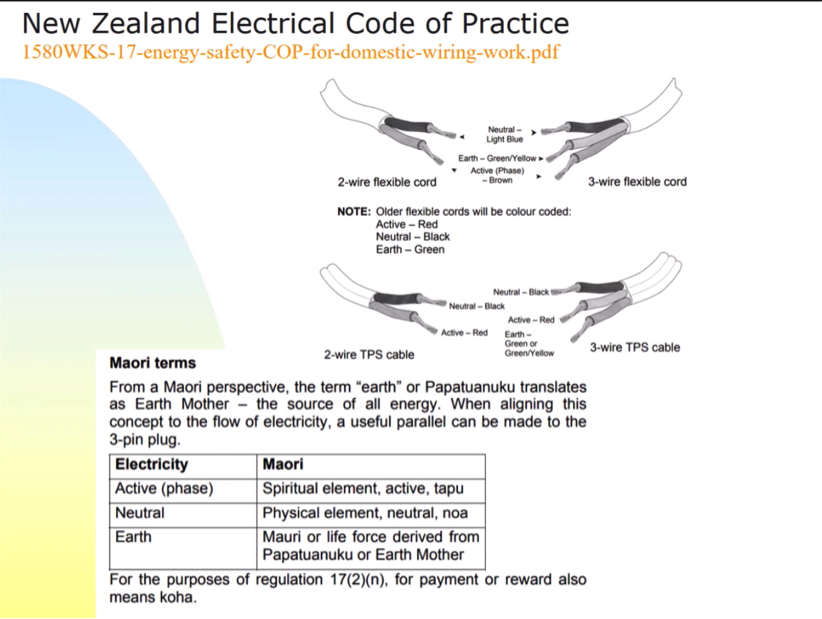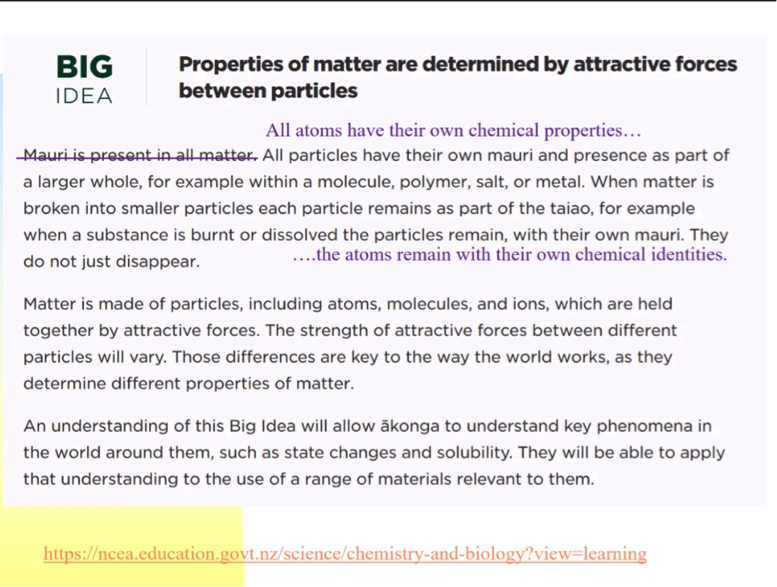Chemistry Professor Paul Kilmartin on "mauri" in the NZ Chemistry/Biology curriculum
![[Prof. Paul Kilmartin university webpage]](/uploads/2022/Paul_Kilmartin.png)
On Friday, February 18, I attended (on Zoom) a fascinating seminar given by Paul Kilmartin, Professor of Chemistry in the School of Chemical Sciences at the University of Auckland, here in Aotearoa/New Zealand. (I work in the School of Biological Sciences at the same institution.) Prof. Kilmartin specialises in wine chemistry, among other things, and in addition to chemistry, has degrees in theology and philosophy.
Kilmartin’s talk was entitled “Chemistry and Mātauranga Māori: A Conversation.” Kilmartin has given me permission to quote this part of his talk, below, which covers science education material of international interest. I will also include the talk summary. Other parts of Kilmartin’s seminar focused on his own background coming to this issue (Scottish and Māori ancestry, member of Ngāi Tahu, deep knowledge of Ngāi Tahu history and land claims), and ideas for Auckland’s chemistry program to explore regarding mātauranga Māori.
The Panda’s Thumb blog has an international readership interested in science and science education, and I have been involved with science education controversies for 20 years (and with PT for 18!). But I’m sure the NZ situation is new to many readers. Therefore, I will give some background/introduction to the controversy around the science curriculum, after the quote from Kilmartin’s talk. For more (much more) on current science education controversies in New Zealand, please search Google News, Twitter, blogs etc. on the various terms mentioned.
(Please not that all of non-talk material is written by me, and should not necessarily be taken as Kilmartin’s views. And, these are my personal views, not those of current or former employers.)
Quotes from: “Chemistry and Mātauranga Māori: A Conversation”
Seminar by Professor Paul Kilmartin
School of Chemical Sciences, University of Auckland
[Comments/clarifications by Matzke are in square brackets like this.]
[Seminar given on Zoom by Prof. Paul Kilmartin at 2022-02-18 at 11 am.]
[Around 27 minutes in, Kilmartin continues...]
The second Ministry of Education text I would like to comment upon concerns proposals for NCEA science. The courses here involve so-called Big Ideas, and the inclusions of concepts drawn from Mātauranga Māori.
These were proposed last year for inclusion in the NCEA curriculum, and have been piloted in some schools.
I understand that this year, a further 5 schools will be involved in mini-pilots, with full pilots to take place next year, and full implementation by 2024.
One of the Big Ideas in the Chemistry area has to do with the properties of matter, as follows:
But what is mauri? Its definition is important for teachers and students alike.
The following Glossary is provided, where mauri is defined as:
[Then follows several minutes of discussion of various definitions and usages of the mauri concept; Kilmartin states that insofar as mauri is used to refer to a concept like individual or ecosystem health, he can work with it. Kilmartin also discusses Prof. T.K.K.B. Morgan's mauri-o-meter, etc.]
[Resume at about minute 33:00]
But is there more to the concept of mauri than this? In an earlier publication, within a civil engineers' proceeding, Prof. Morgan provides more background to mauri.
And there are some new concepts here. Not only do all natural objects possess it, mauri is seen as the binding force between the physical and the spiritual. Indeed, when mauri is impacted and the bond weakened, the physical and the spiritual are separated, leading to death.
One question is whether using mauri in the sense of life-supporting capacity implies all of this additional meaning. If it does, then I would want to ask, Who discovered this binding force between the physical and the spiritual? And what evidence was involved in its discovery? If this binding force is real, then everyone needs to know about it. It needs to be in the chemistry syllabus of every country, not just in New Zealand.
So how has this new syllabus been received by teachers? We have one publication on this topic from last year [Stewart and Tedoldi 2021], which explains that the inclusion of Māori concepts is an attempt to reflect the principal of equal mana, mana ōrite, for Māori knowledge -- one of the seven principles within the NCEA Change package, announced by the government in May 2019.
We also learn that these proposals have sparked heated discussions, in which NCEA science teachers have referred to Māori knowledge as "myths and legends," or "’spiritual concepts’ that do not belong in the science curriculum." Well, good on the teachers for having their say.
The authors of this article [Stewart and Tedoldi 2021] have other views. The problem with the teachers is seen as a narrow understanding of what is living, as taught under the "MRS GREN" life processes: Movement, Respiration, Sensitivity, Growth, Reproduction, Excretion, and Nutrition, and I remember teaching MRS GREN in my two years as a secondary school teacher in Christchurch in the early 90s. Instead this should be expanded to consider a river as living. To support this understanding, teachers are recommended to look to the Gaia concept of the Earth as a living thing. I hadn't heard much about Gaia recently, and it was much more popular in the 80s and 90s, and I might be showing my age here. I had to look up Wikipedia for some recent information. There is every indication that Gaia has little current following in the scientific community, after some years of more active debate.
One final example of mauri is of interest to myself as an electrochemist, given our use of electricity to interface with chemistry. And this relates to domestic electrical wiring. In the current New Zealand Electrical Code of Practice, we are encouraged to think of the Green/Yellow=Earth wire as a Papatuanuku or Earth Mother.
I must admit, I do have trouble taking this seriously, and I doubt the use of tapu and noa in this matter matches their meaning within Mātauranga Māori.
My own view is that the concept of mauri has no place in the Chemistry curriculum. I would suggest to re-write the Big Idea along these lines:
[...]
[References cited above]
Georgina Stewart and Angelo Tedoldi (2021). Bringing Māori concepts into school science: NCEA. Access: Contemporary Issues in Education. 41(1), 77-81. https://pesaagora.com/access-vol-41/bringing-maori-concepts-into-school-science-ncea/
Gaia – Wikipedia. Wikimedia Foundation. Accessed 2022-02-18. https://en.wikipedia.org/wiki/Gaia
T. K. K. B. Morgan (2006). Decision-support tools and the indigenous paradigm. Proceedings of the Institution of Civil Engineers - Engineering Sustainability. 159(4), 169-177. December 2006. https://www.icevirtuallibrary.com/doi/10.1680/ensu.2006.159.4.169
NCEA (2021). Science: Chemistry and Biology. NCEA Level 1 Curriculum.
https://ncea.education.govt.nz/science/chemistry-and-biology?view=learning . Accessed 2022-02-18.
NCEA (2021). Chemistry and Biology Glossary. NCEA Level 1 Curriculum.
https://ncea.education.govt.nz/science/chemistry-and-biology?view=subject-glossary . Accessed 2022-02-18.
To give a fuller summary of the talk, here is the poster advertising and summarising Kilmartin’s seminar:
![[Paul Kilmartin poster for Feb. 18 chemistry seminar on mātauranga Māori]](/uploads/2022/Paul_Kilmartin_talk_poster.png)
And the text for the same:
Poster and summary of Kilmartin Seminar
School of Chemical Sciences - Friday Seminar Series
Friday 18 February 2022
11 am
Chemistry and Mātauranga Māori
A Conversation
Professor Paul Kilmartin
School of Chemical Sciences, University of Auckland
https://unidirectory.auckland.ac.nz/profile/p-kilmartin
The NCEA Education web-site provides the following material for the “Big Idea” named “Properties of matter are determined by attractive forces between particles”, prepared for teaching Chemistry and Biology as a consolidated subject at Curriculum level 6 (NCEA 1):
Mauri is present in all matter. All particles have their own mauri and presence as part of a larger whole, for example within a molecule, polymer, salt, or metal. When matter is broken into smaller particles each particle remains as part of the taiao [environment], for example when a substance is burnt or dissolved the particles remain, with their own mauri.
A glossary definition of mauri is also provided:
The vital essence, life force of everything: be it a physical object, living thing or ecosystem. In Chemistry and Biology, mauri refers to the health and life-sustaining capacity of the taiao, on biological, physical, and chemical levels.
https://ncea.education.govt.nz/science/chemistry-and-biology?view=learning
This presentation will provide a personal perspective on several issues related to Chemistry and Mātauranga Māori. These will include selected points from Ngāi Tahu/family history, through to a critique of recent Ministry of Education publications where Mātauranga Māori concepts are being brought into the School curriculum.
The presentation will be organised around the following topics:
Moa bones and the Kemp purchase
Rowallan land blocks
The Opihi Taniwha
Ngā Tautake Pūtaiao me ngā Kōrero o Mua
Chemistry curriculum
Legitimate voices
Future opportunities for the School of Chemical Sciences
A 45 minute presentation will be followed by ample time for discussion.
In addition to his chemistry background, Paul has degrees in philosophy and theology, and is a Trustee on two blocks of forested land provided to the family under 1906 SILNA act. His research into family history has been deposited with the Ngāi Tahu whakapapa unit.
Quick Backgrounder for international readers (by Matzke)
The term mātauranga Māori means Māori knowledge. (It is often just “mātauranga” when the context is obvious; it is often also abbreviated MM.) Often this primarily refers to traditional indigenous knowledge, but it can also include newer knowledge that was developed or incorporated more recently. Much more detail is available via google, see for example the Māori dictionary and mātauranga Māori and science, from the NZ Science Learning Hub.
I was hired in NZ in 2018, and I have gradually learned of a widespread movement to promote MM at all levels. For example, it is an aspect of Vision Mātauranga, the governmental strategy for encouraging scientific research that benefits Māori interests. It is promoted in university strategic plans, and in school systems. All of this is motivated by many honorable values. I cannot list them all, but motivations include everything from (1) making science education and research more interesting and relevant to Māori students, through to (2) encouraging Māori cultural advancement and renewal (much like government promotion of te reo Māori, the Māori language) – especially important to help repair damaged caused by colonisation, through to (3) economic and conservation benefits that could accrue from deploying traditional knowledge.
All of this is well and good, and it is hard to see how anyone could reasonably object to these ideas in general. However, specifics and implementation matter a lot, and controversy has recently arisen over a governmental policy to revise the school curriculum with guideline mandating “parity” between “Western science” and mātauranga Māori. In July 2021, seven professors (full or emeritus) from the University of Auckland wrote a letter to a NZ magazine, The Listener, objecting to this and other Ministry of Education statements. The initial reaction was swift and harshly negative, as some perceived the letter as denigrating mātauranga. But over time a more normal public discussion ensued in The Listener and elsewhere (which is ongoing), and now the Vice Chancellor of the University of Auckland, Dawn Freshwater, has stated “Nobody is wrong here,” and promised to host an academic symposium to thoroughly discuss the various issues raised.
(The symposium was going to be in the first quarter of 2022, but now the omicron variant of SARS-CoV-2 has slipped through quarantine, and NZ is experiencing it’s first huge wave of SARS-CoV-2. I say SARS-CoV-2, because NZ is highly vaccinated and omicron is milder, so hopefully we will avoid most of the actual Covid disease. In any case, the University of Auckland is online-only (mostly) for at least the first half of Semester 1, so I imagine the symposium will likely be delayed.)
I was not involved in The Listener controversy, except to try to defend the principle of academic freedom of everyone involved. To me, the word “parity” could mean a lot of things, NZ generally seems like a place where common sense prevails (rather than everything going to the nuclear option of litigation or political polarisation, as occurs in the USA), and in any case I’m just a recent immigrant, lucky to be here. It seemed to me that the whole debate needed to happen in long-form (rather than letters, petitions, and tweets) where issues can be discussed thoroughly, and perhaps now this will happen in the VC’s Symposium.
However, there has been a new development. The NZ Ministry of Education’s NCEA (“National Certificate of Educational Achievement”) released its curricula for a variety of classes at NCEA Level 1 (translation: students approximately age 15-16). NCEA Levels 2 and 3 are essentially university preparatory material, and include high-stakes exams run by NZQA, relevant for credits for University admissions. Level 1 is more basic material, and some students choose to skip Level 1 to go straight to higher levels, but the “NCEA Change Process” will move to Levels 2 and 3 when NCEA Level 1 changes are completed.
NCEA Level 1 includes classes on Chemistry and Biology (CB), general Science (SC), Physics Earth and Space Science (PESS), and Mathematics and Statistics (MS). Reviewing the curricula, some of it, including some of the mātauranga Māori content, seems fine, or at least not something to raise a public ruckus about. (E.g., the curriculum is often pretty vague and general, but NZ deliberately decided to not create hyper-detailed curricula like the 1000+ page curricula used in Australia.)
But some of it is…very surprising. The example that leapt out to me is also the section that Kilmartin critiqued: the chemistry discussion of atoms, molecules, chemical bonds, and conservation of mass/energy/the First Law of Thermodynamics.
Here is some quick translations for the international reader. Please see the NCEA glossary or other online resources for more:
- ākonga = students
- taiao = the environment
- kaitiakitanga = guardianship and protection, e.g. of the environment
- whakapapa = genealogy framework used to record relationships (genealogical or otherwise), but more generally, it is often used to refer to heritage, inheritance, cultural and familial connections, etc.
- mauri (quoting from the NCEA Glossary) = "The vital essence, life force of everything: be it a physical object, living thing or ecosystem. In Chemistry and Biology, mauri refers to the health and life-sustaining capacity of the taiao, on biological, physical, and chemical levels."
The NCEA Chemistry and Biology curriculum says (or said as of November 2021, if they change it, which they eventually will have to):
Big Idea: Properties of matter are determined by attractive forces between particles Mauri is present in all matter. All particles have their own mauri and presence as part of a larger whole, for example within a molecule, polymer, salt, or metal. When matter is broken into smaller particles each particle remains as part of the taiao, for example when a substance is burnt or dissolved the particles remain, with their own mauri. They do not just disappear.
What is meant by “mauri” here? We might avoid conflict by imagining that the term is being used here to refer to individual or ecosystem health, as it is some other places in the curriculum. Elsewhere in his talk, Kilmartin notes that concepts of health are something that he can work with as a scientist, and I agree. For example, a toxin might damage an individual organism, chemical pollution might damage an ecosystem, etc.
But that interpretation cannot be applied to this Big Idea. For starters, virtually all matter in the Universe has zero to do with health of living things, because it is outside of our solar system. Even if we stretch the health interpretation to some science fiction scenario where humans and other Earth organisms have escaped our solar system, most of the relevance of various “particles” to organismal/ecosystem health is not due just to the particles’ properties; we must also consider their temperature, arrangement, relative amounts, and the needs of the various organisms. Methane in large amounts is toxic to humans, healthy to certain microorganisms, and deadly to all of them on Titan where the temperature is -179.6 degrees Celsius on a hot day.
And, in any event, whatever “life-sustaining” capacity of a particle we might imagine, it decidedly does not remain upon being burnt. Oxygen (O2) is necessary for human life, but carbon dioxide (CO2), the product of burning carbon-containing compounds like methane in oxygen, is toxic at sufficient levels. If by “particles”, the NCEA actually meant “atoms”, (a) they should have just said that, and (b) while the “atom” interpretation does refer to something that doesn’t change upon burning, understanding atomic properties is fairly remote from understanding health impacts, which mostly concern how molecules interact with organismal processes, and (c) the term “particles” explicitly refers to “molecule, polymer, salt, or metal” in the standard.
The passage does not make sense if interpreted as referring to health impacts. What we are left with is the more fundamental definition of mauri, which is closer to its original usage anyway, which is the “vital essence, life force of everything.”
But the concept of a life force or vital essence is…vitalism! And vitalism is a very old, and very very discredited idea. Wohler’s 1828 synthesis of urea from inorganic compounds, when it was previously thought to be an organic molecule produced only by life, was later recognized as an early episode in the defeat of vitalism, and is cited in virtually all chemistry textbooks and classes.
(Note that, as is always the case when the history of science is explored in depth, the history is more complex than the defeat of vitalism in a single experiment. Vitalism was an amorphous doctrine, not refutable by a single experiment, but it died a gradual death by many cuts, as experiments accumulated that synthesized various organic compounds from inorganic sources. See Ramberg 2000.)
Modern chemistry and biology, especially organic chemistry and biochemistry, essentially arose through the examination and experimental defeat of vitalism, including the defeat of many rear-guard attempts to defend some reduced version of the concept of a life force or life essence – something “extra” beyond material matter and forces which gave living things the breath of life. To have some government bureaucrats try to bring it back into chemistry by administrative declaration is not going to fly. Seeing vitalism in chemistry standards is as surprising as it would be to see a Geology curriculum endorse Noah’s Flood or the idea that the Earth is 6,000 years old.
These problems should have been obvious, and they certainly were to the many science teachers who objected. Unfortunately, science teachers’ objections seem to be being hand-waved away by the educational establishment, for example by Stewart & Tedoldi (2021), who seem to be closely involved with the science curricula. They note the strong objections that science teachers voiced to bringing mauri into the Chemistry/Biology curriculum in this way, but they reply by bringing up…Gaia. Even if one ignored Kilmartin’s point, namely that the Gaia Hypothesis is itself controversial, Gaia aims to explain how the Earth is a homeostatic system; it doesn’t solve the problems with trying to bring back vitalism.
But there are other huge problems with the inclusion of mauri in the discussion of particles, chemical bonds, and conservation of mass. These include: What will be on the exams? Will one question be a chemical formula, and the next a spiritual concept? Won’t the inclusion of spiritual concepts in amongst basic chemistry concepts create conflict in the classroom between students (or teachers) with differing spiritual views? Is this even authentic mātauranga, or is it actually something hatched in the bowels of the Ministry of Education in mid-2021 in the service of some goal other than science education? And, especially, how did all of this get pushed through over negative reviews that the Ministry must have gotten from scientists and science teachers?
(Also, where is the “e-word”, evolution? Avoiding the e-word in Biology curricula is often a warning sign in itself. Perhaps the idea is that it can be replaced with the concept of whakapapa, but everything I’ve heard suggests it is wildly oversimplified and basically wrong to equate evolution/phylogeny with whakapapa. But perhaps the Ministry of Education thinks it can just declare they are the same.)
Finally, there is a rather profound meta-issue that keeps arising in these discussions, namely, “Who has the authority to speak?” Professor Kilmartin (in a part of the talk I did not quote) argues strongly that everyone should be allowed to participate in the discussion – scientists, mātauranga Māori experts, and the general public whose children will be educated under these curricula in the schools. I agree, but there is another point worth making. When the subject is a public school curriculum, we should keep in mind the purpose of such curricula: to get everyone on the same page, to supply the basic concepts and definitions and will be taught. If an introductory curriculum requires a complex hermeneutic to correctly interpret it, or if advanced knowledge is required to understand it, then the curriculum is failing at its basic purpose. Being simple and clear, providing a common baseline for everyone, is the whole point of a curriculum.
However, this post is long enough as it is, so these other questions will have to wait for future posts. I do encourage others concerned about the situation with science standards in New Zealand to get in touch (nickmatzke@gmail.com); the way that problems like this can get solved is by activism.
NCEA/Ministry of Education (2021). SCIENCE: Chemistry and Biology Level 1 Curriculum. https://ncea.education.govt.nz/science/chemistry-and-biology?view=learning. Accessed 2022-02-21.
John Ross (2021). Does the teaching of indigenous knowledge need to be examined? New Zealand’s embrace of Māori vocabulary goes hand-in-hand with the incorporation of Māori understandings into curricula. But is a debate about the unintended consequences of this move being stifled by fear of speaking out? Times Higher Education, November 11, 2021. https://www.timeshighereducation.com/depth/does-teaching-indigenous-knowledge-need-be-examined
John Ross (2021). Auckland plans dialogue on Māori knowledge and science: Vice-chancellor commits to ‘challenging and confronting debate’ on hot-button issue. Times Higher Education, December 15, 2021. https://www.timeshighereducation.com/news/auckland-plans-dialogue-maori-knowledge-and-science
Peter J. Ramberg (2000) “The Death of Vitalism and The Birth of Organic Chemistry: Wohler’s Urea Synthesis and the Disciplinary Identity of Organic Chemistry.” Ambix, 47:3, 170-195, DOI: 10.1179/amb.2000.47.3.170 To link to this article: https://doi.org/10.1179/amb.2000.47.3.170
Georgina Tuari Stewart and Angelo Tedoldi (2021). Bringing Māori concepts into school science: NCEA. Access: Contemporary Issues in Education. 41(1), 77-81. https://doi.org/10.46786/ac21.1591
Ian Wilkinson (2002). “History of Clinical Chemistry.” The Journal of the International Federation of Clinical Chemistry and Laboratory Medicine (EJIFCC). 13(4): 114–118. https://www.ncbi.nlm.nih.gov/pmc/articles/PMC6208063/
Note: I am going to be out of town and off the grid on a trek, so I ask other PT moderators to please eliminate spam and trolling in the comments, if any.

